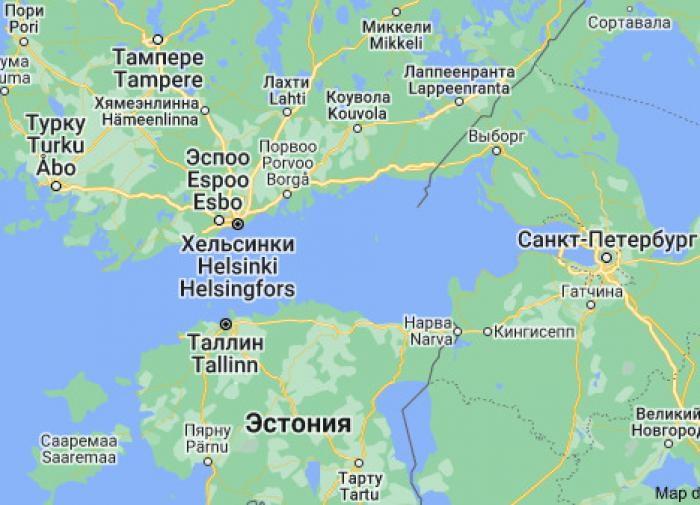Estonia plays on Russia's nerves by closing the Gulf of Finland
Estonia and Finland, with the consent of the EU may create problems for the Baltic Fleet of the Russian Federation. The Baltic States increase their destructive actions, provoking Moscow to respond.

Estonia's actions overwhelm Moscow's patience
In early January, Estonia announced a legal plan to confiscate Russian assets that had previously been frozen in the midst of EU sanctions frenzy. The EU supported the plan.
Two weeks ago, the Estonian Foreign Ministry demanded the number of employees of the Russian Embassy in Tallinn be reduced by three times — to 8 diplomats and 15 seconded workers.
The ministry then announced an intention to introduce a coastal "contiguous zone" regime in the Gulf of Finland to ensure better enforcement of sanctions against Russia and capture those who violate them, News | ERR said.
On Monday, Tallinn announced the transfer of €113 million in Estonian military aid to the Armed Forces of Ukraine, including "all FH-70 155-mm howitzers", as well as D-30 122 mm howitzers, artillery shells and Carl Gustaf M2 anti-tank grenade launchers.
Against the backdrop of the above-mentioned anti-Russian actions, the Russian Foreign Ministry ordered the Estonian ambassador to leave the Russian Federation on February 7. Estonia announced the return expulsion of the Russian ambassador. As a sign of solidarity with Estonia, Latvia also decided to expel the Russian ambassador from the country.
Estonia's contiguous zone will ensure inspection of Russian ships
The coastal "contiguous zone" in the Gulf of Finland, where all ports of the Russian Federation in the Baltic Sea are located requires an explanation here.
According to News | ERR, the creation of this zone under the 1982 Convention on the Law of the Sea, will ensure compliance with Estonian legislation at a distance "up to 24 nautical miles (approximately 44 km) from the baseline of the country's territorial sea". In a nutshell, it goes about 12 miles of territorial sea and 12 miles of the contiguous zone.
"This zone will have a positive impact on Estonia's national security, as well as its ability to protect the environment and archaeological and historical sites within its territorial sea," Estonian Foreign Minister Urmas Reinsalu said in a press release.
Alexander Lott, an officer at the Norwegian Centre for Maritime Law (NCLOS) and a lecturer in administrative law at the University of Tartu, told News | ERR that the contiguous zone could be "established by national law, where the coastal state has the power to both control and punish violations of its own law."
According to him, the right of the state to exercise legal powers in the contiguous zone extends to economic legislation, such as customs and taxation, as well as other branches of legislation related to sanitation and immigration.
"One of the reasons for the desire to create such a zone could be the goal "to better ensure the implementation of sanctions against Russia," Alexander Lott said. It will also be possible to ensure the capture of those who violate those sanctions.
"The contiguous zone is intended for these measures in the first place. It is the most effective way to bring ships to justice in the contiguous zone if they violate customs or fiscal laws of the coastal state," Lott said.
Estonia needs to negotiate with Finland
Art. 24 of the Convention on the Law of the Sea stipulates for the following:
"Where the coasts of two States are opposite or adjacent to each other, neither of the two States is entitled, failing agreement between them to the contrary, to extend its territorial sea beyond the median line every point of which is equidistant from the nearest points on the baselines from which the breadth of the territorial seas of each of the two States is measured."
The distances between the coasts of Estonia and Finland in the Gulf of Finland measure from 70 to 100 km. Such a distance does not allow uncoordinated introduction of adjacent zones. Estonia and Finland have set the boundaries of their territorial waters in the Gulf of Finland in a way to ensure free navigation of three nautical miles on either side of the median line of the Gulf.
Therefore, in order to impose sanctions against the Russian Federation, Estonia needs to either negotiate with Finland or extend this zone further to the west. There are other Russia-unfriendly states along the line in the Baltic Sea, and it is not going to be difficult to win their support.
Estonia provokes Russia to military conflict
Political scientist Andrei Suzdaltsev believes that Estonia is provoking a conflict, "and maybe a war."
"When coordinating the positions of Tallinn and Helsinki, these two countries, one of which is a NATO member, may interfere with the work of Russia's largest port of St. Petersburg, which is also the largest port in the Baltic Sea," Suzdaltsev wrote in his Telegram channel.
Tallinn will need the support of both the EU and NATO for the purpose, the political scientist believes.
In response, Russia will close the Northern Sea Route for Western fleets. Moscow may also revise a number of agreements with Norway and Japan, as well as with the United States in the Bering Sea.
Subscribe to Pravda.Ru Telegram channel, Facebook, RSS!


